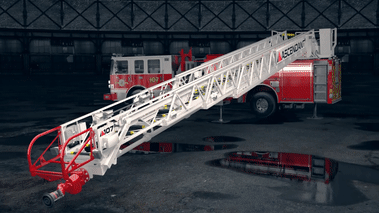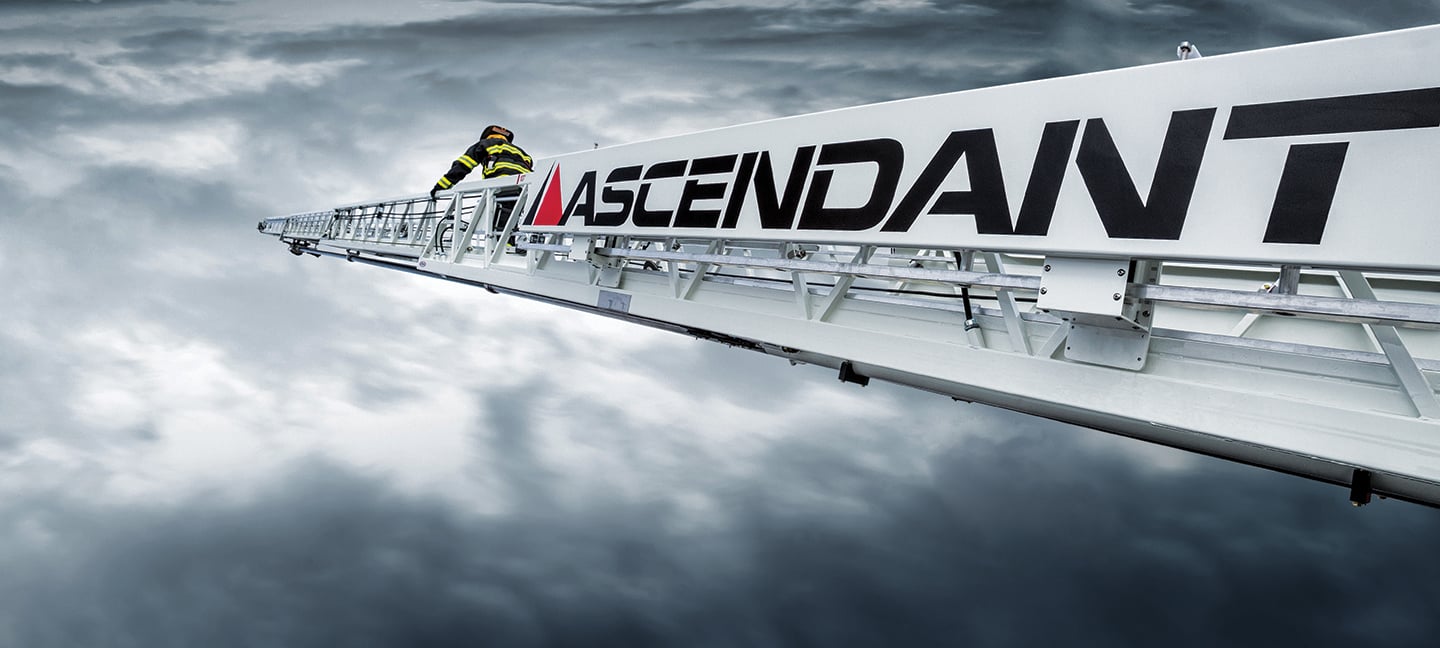Ascend to a whole new level.
Go where no aerial apparatus has gone before. And do so with the heavy-duty capabilities you deserve.
Overview
Go where no aerial apparatus has gone before. And do so with the heavy-duty capabilities and dependability you deserve.
The Ascendant 107' Heavy-Duty Ladder truly redefined the single rear axle aerial market, providing firefighters with an unprecedented 107' of vertical and 100' of horizontal reach without compromising on water capacity, performance or safety. The heavy-duty 100,000 psi high-strength steel ladder was purpose built using proven engineering practices. Since the launch, firefighters have made it clear that we need to be able to offer our innovative Ascendant ladder on other configurations.
The Ascendant technology has expanded into 6 innovative products. The Ascendant Class of Aerials was brilliantly engineered to equip firefighters with more aerial choices than ever before. Whether it be weight restrictions, compartment space, preference to ride rather than climb, the lower cost of ownership or rescue capabilities, the Ascendant technology provides flexibility and a wide range of options to meet each department’s needs.


Comparisons
{{index}}
| {{specification.label}} |
{{index}}
| {{specification.label}} |
FAQs
Up until this point, compromises with overall length, weight and performance had to be made with traditional mid-mount platforms. The new Ascendant 100’ Aerial Tower eliminates these compromises with superior maneuverability, drivability, operability and serviceability.
Yes, the 100’ Aerial Tower is designed to operate on a 5° side slope and up to 9° downward slope.
The design, strength, and durability of the Ascendant 100’ Aerial Tower has been rigorously tested. The aerial tower has passed all NFPA structural and stability testing requirements.
Unlike other mid-mount platforms, the position of the pump on the 100’ Aerial Tower provides the flexibility to add plumbing options into larger pump houses. Larger pump houses will increase the wheelbase and impact maneuverability.
Yes, the Ascendant is a heavy-duty steel ladder at a 750 lb (dry) tip load, 1,500 gpm water flow, 2:1 safety factor and 1.5:1 stability. The Ascendant has been purpose built using proven engineering practices. The Ascendant® design has been optimized to place material where needed and eliminate material where it is not necessary. Using a third party, Pierce certifies every aerial to the stringent UL Type I requirements and every single vehicle to NFPA compliance requirements.
The Ascendant is purpose built using proven engineering practices. The Ascendant ladder is not a new ladder structural design as lattice design aerials have been around for well over 100 years; it is simply an optimized design structure.
The design, strength and durability of the Ascendant ladder have been rigorously tested. The aerial passed all NFPA structural and stability testing requirements prior to its launch and since that time, Pierce’s Research and Development team successfully completed a fatigue test, lifting a 750 lb tip load weight plus 100 lb of equipment load, a total of 130,000 cycles at full extension. To put 130,000 cycles into perspective: That’s simulating approximately 17 cycles at rated tip load per day, every day, for 20 years.
The Ascendant ladder was launched at FDIC 2015 and has received high praise from the industry. The 107' Ascendant is the most popular new aerial product offering in the history of Pierce with hundreds being sold.
Yes, an apparatus with the Ascendant 107' ladder can be set up on varying grades with the vehicle in either the uphill or downhill position. The product is designed to be operated on a 12% uphill slope and a 9% downhill slope while meeting all NFPA stability requirements.
Comparative braking studies demonstrate the 56,000-lb Ascendant stops 50' shorter than a 72,000-lb 105' tandem axle aerial. So you may ask, how can a truck with two axles (one front axle and one rear axle) stop in a shorter distance than a truck with three axles (one front axle and two rear axles) and more brakes?
During heavy braking, weight is transferred from the rear axle to the front axle. We can feel this effect on our bodies as we are thrown against the seat belts. Because a deceleration force acts at the center of gravity of a vehicle, and because the center of gravity of the truck is located somewhere above the ground (the center of gravity on an aerial is even higher), weight will transfer from the rear axle to the front axle in direct proportion to the rate of deceleration. In so many words, this is the effect of weight transfer under braking which can be as high as 70% or more. This is why most vehicles have larger front brakes.
When it comes to aerials, the center of gravity is much higher and the weight is much greater than an automobile, consequently the impact is also greater. In the case of a 56,000-lb Ascendant, over 39,000 lb (70% of 56,000 lb) of force can be on the front brakes. Compare that to a much heavier tandem axle aerial weighing 72,000 lb, which could apply 50,000 lb to the front brakes. Consequently, the heavier vehicle will take longer to stop and exhibit higher brake and tire wear, increasing its cost to the owner over time. Furthermore, all rear tires, brakes, axle and springs on the Ascendant are rated for 33,500 lb continuous duty (not intermittent use like the 35,000 lb rear axle).
In total, with water and foam, the 107' Ascendant on a 33,500 lb single rear axle can accommodate an impressive 500 gallons with 2,500 lb of equipment, full hose complement and a big block engine (if desired). This 500 gallons can be configured on any of the custom chassis offerings for the Ascendant ladder (Enforcer, Arrow XT, Velocity or Impel).
The 107' Ascendant heavy duty ladder is available on a wide range of body styles providing firefighters flexibility and a wide range of options to meet each department’s needs. The Ascendant is available with a quint style body, a Texas Chute Out style body for departments desiring a side stacked hose bed, and a true truck company body style with no pump or tank. Compartment space varies, ranging from 144 cubic feet to 306 cubic feet depending upon the body style selected. This compares to a typical tandem axle quint at approximately 165 cubic feet. Pierce calculates compartment space by measuring the volume of the body compartments and excluding air bottle compartments, ladder storage chutes and hose bed space. Additionally, the Ascendant is available with our exclusive Pierce PUC pump for departments that desire increased compartment space, maneuverability and serviceability.
The Ascendant meets and in most areas exceeds NFPA 1900 requirements for a quint with up to a 2,000 gpm pump, a 500 gallon water tank, capacity for 1,000' of 5" hose, a 107' heavy-duty ladder device and up to 200' of ground ladders.
There are significant performance enhancements in integrating the Ascendant ladder on this tandem axle chassis configuration. For starters, you’ll have improved aerial performance with the Ascendant heavy-duty ladder with 107' vertical reach, 100' horizontal reach, a 750 lb tip load and 1,500 gpm flow.
Additionally, the optimized design of the Ascendant ladder results in a significantly lighter vehicle with a rear axle rating of only 44,000 lb. A lighter weight vehicle provides numerous benefits: Departments in weight restrictive states can now have an Ascendant tandem axle configuration in their fleet; the costs of ownership are lower with less brake and tire wear; stopping distances are shorter and departments will realize better performance from the chassis drivetrain.
A tandem axle chassis with an Ascendant ladder will also be easier for you to set-up and position. There will still be 4 stabilizers for this configuration but only the front stabilizers are H-style outriggers – the rear 2 stabilizers are downriggers, which reduce the set-up footprint. As standard the torque box and stabilizers are e-coated for improved corrosion resistance. The Ascendant heavy-duty ladder on a tandem axle chassis is available on a wide range of body styles providing firefighters flexibility and a wide range of options to meet each department’s needs.
The Ascendant provides firefighters with 107' of vertical reach and 100' of horizontal reach without compromising on water capacity, performance or safety. The Ascendant is rated at a 750 lb (dry) / 500 lb (wet) tip load capacity with an additional 100 lb equipment allowance. It can flow up to 1,500 gpm and is capable of a store front blitz feature as standard.
The Ascendant heavy-duty ladder on a tiller configuration offers numerous advantages and performance enhancements, resulting in longer reach both vertically and horizontally, higher tip loads and higher flow ratings. You’ll still have all the same performance characteristics of the Ascendant heavy-duty ladder that you’re accustomed to – 107' vertical reach, 100' horizontal reach, 750 lb tip load and 1,500 gpm flow without compromising on water capacity, performance or safety. Additionally, we’ve improved your set-up capabilities by increasing the allowable jack-knife angle to 60°. And, one more thing: We’ve reduced the overall vehicle weight of this configuration by 4,000 lb. We're giving fire departments more flexibility with their configurations– whether it be lighter axle ratings, increased water capacity or more storage options.
Truly another game changer. We’ve taken the Ascendant single rear axle quint configuration and made it even better with the addition of a platform basket. Imagine that… for those who would rather ride than climb or departments in weight restrictive states who could never even consider a heavy, tandem axle aerial platform – the Ascendant heavy-duty aerial platform is your solution!
This configuration will provide 110' of vertical reach and 90' of horizontal reach without compromising on water capacity, performance, or safety. You’ll have a maneuverable, first out quint with full rescue capabilities.
For those of you that want more than just a ladder yet desire a smaller, lighter weight platform basket with lower acquisition costs and less cost of ownership – the Ascendant platform is ideal for you.
The Ascendant heavy-duty aerial platform is available on a wide range of Pierce custom chassis with either a single rear axle or a tandem rear axle to meet your fire department’s needs.
Yes, the Ascendant platform is a fully NFPA compliant ergonomically designed 3-person basket.
The Ascendant platform will provide you with 110' of vertical reach and 90' of horizontal reach without compromising on water capacity, performance, or safety.
The Ascendant platform is rated at a 750 lb (dry) / 500 lb (wet) tip load capacity with an additional 100 lb equipment allowance. It can flow 1,250 gpm from a single monitor located at the end of the fly section. The Ascendant 110' platform allows you access to the basket by extending the device only 8'. It has an impressive operational range of -10 degrees below ground level to 77 degrees above ground level.
The Ascendant platform is available with a single monitor located at the end of the fly section. The Ascendant platform design has been optimized for weight and ultimately maximum performance. In order to maintain the impressive performance characteristics inherent to the Ascendant, the monitor weight and location have also been optimized resulting in a single monitor at the end of the fly section.
Now rest assured, our other Pierce Platform products still exist for those of you who want a larger platform with dual monitors and more equipment allowance – but for those of you who want more than just a ladder, yet desire a smaller, lighter weight platform basket with lower acquisition costs and less cost of ownership – the Ascendant Platform is ideal for you.
